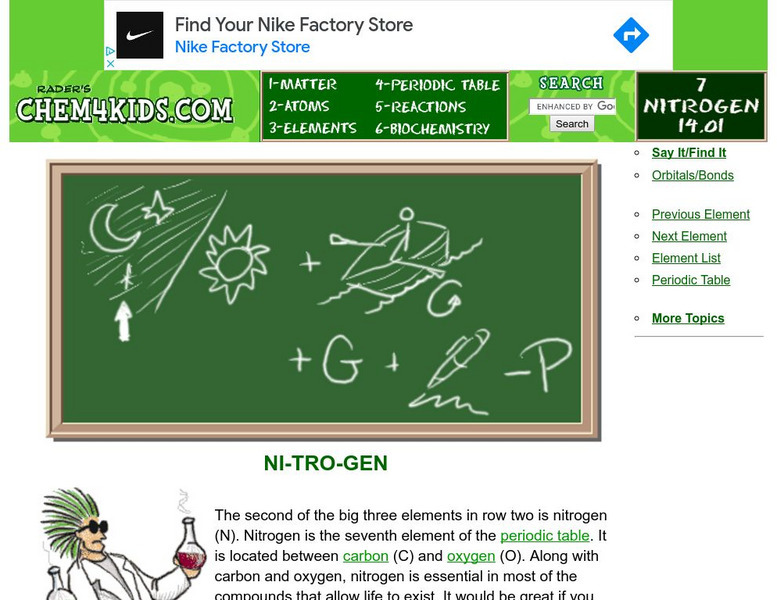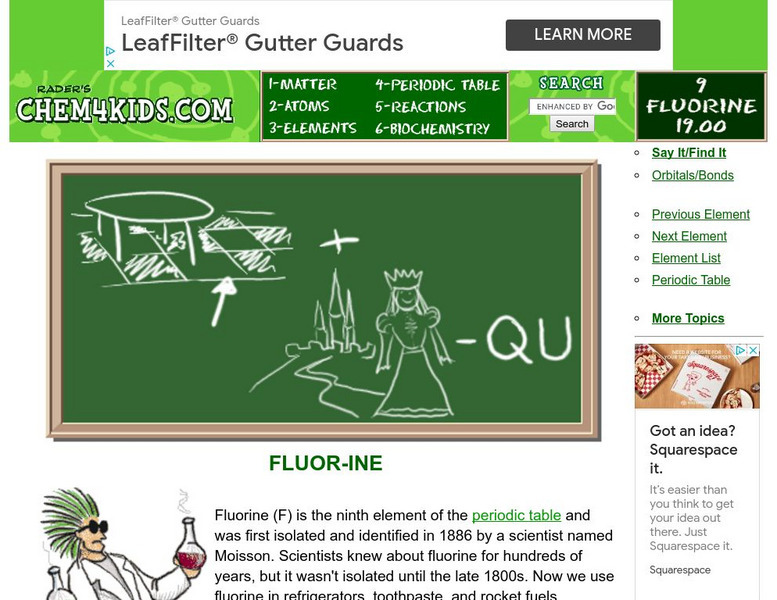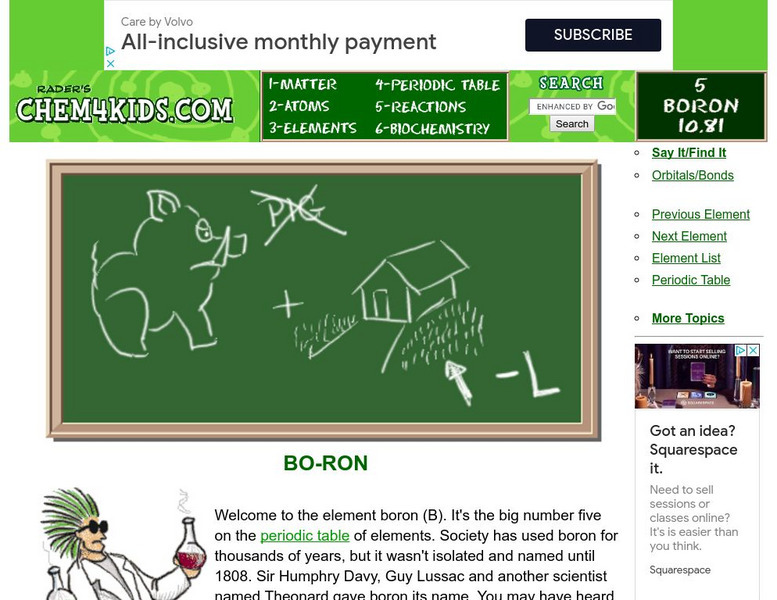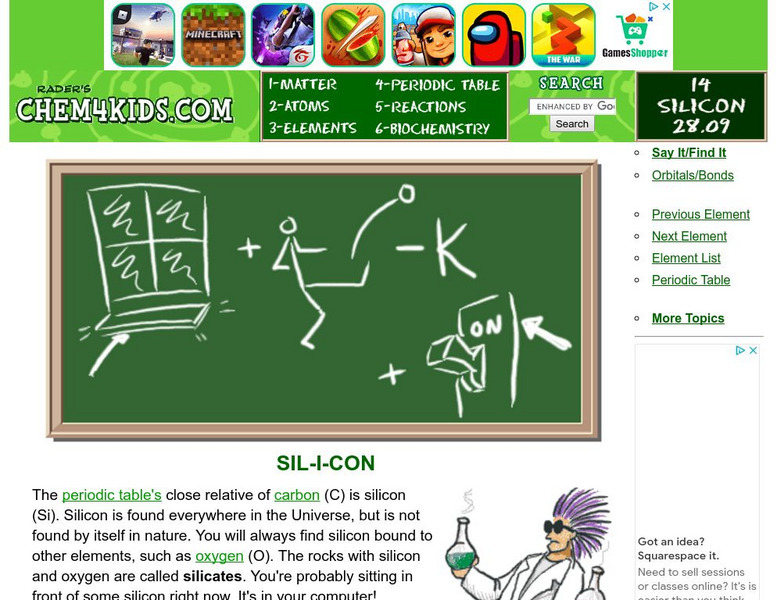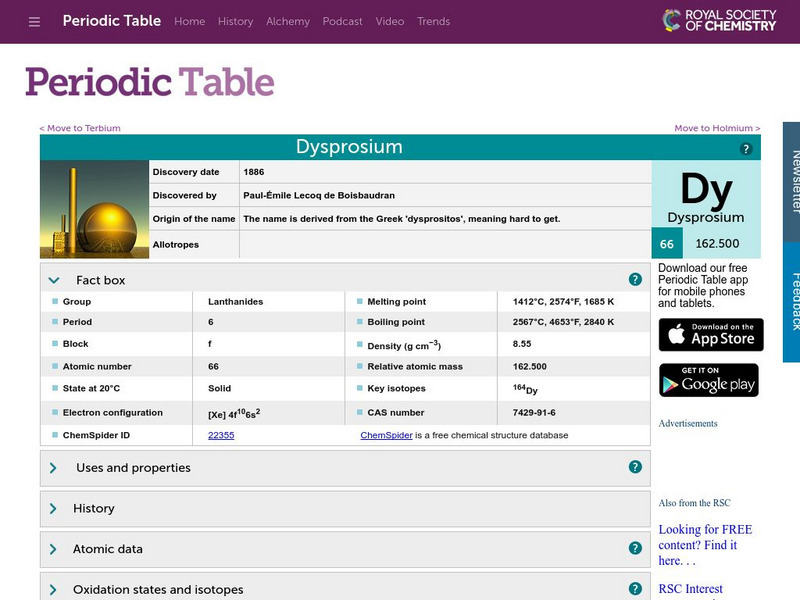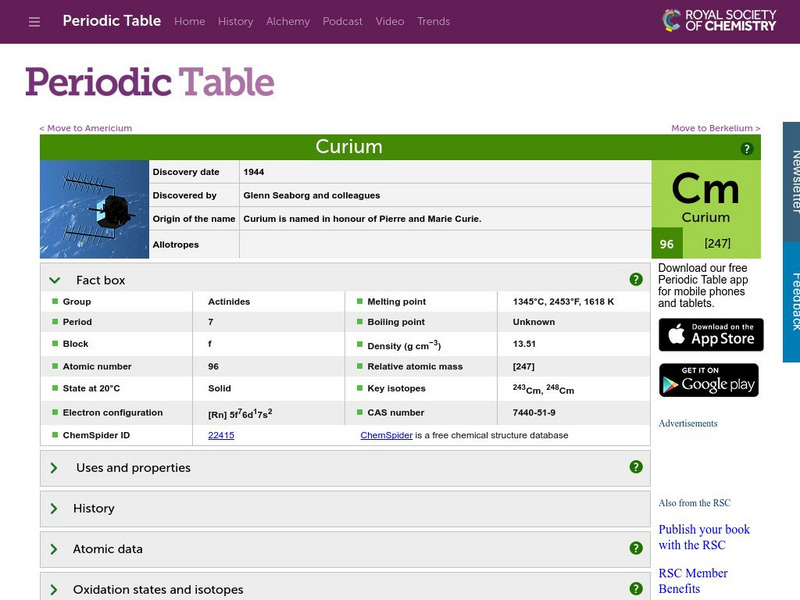Science Education Resource Center at Carleton College
Serc: Elements Metals, Nonmetals and Metalloids
Students investigate several properties of the given elements and decide whether each element is a metal, non-metal, or a metalloid.
Thomas Jefferson National Accelerator Facility
Jefferson Lab: The Element Fermium
A description of the chemical element Fermium. Gives scientific information such as atomic weight and atomic number, and also discusses its history and uses.
Thomas Jefferson National Accelerator Facility
Jefferson Lab: Elements Matching Game
Match the following chemical symbols to their corresponding elements.
CK-12 Foundation
Ck 12: Life Science: 2.1 Elements and Compounds
Learn how basic elements form molecules to support life.
Chem4kids
Chem4 Kids: Nitrogen (N)
Here you can find some great information about the 7th element in the periodic table, "nitrogen." Content focuses on nitrogen's electrons, where you can find nitrogen in nature and in the home, and how nitrogen combines with other elements.
Chem4kids
Chem4 Kids: Fluorine
Here you can find some great information about the 9th element in the periodic table, "fluorine." Content focuses on fluorine's electrons, where you can find fluorine in nature and in the home, and how fluorine combines with other elements.
Chem4kids
Chem4 Kids: Neon (Ne)
Here you can find some great information about the 10th element in the periodic table, "neon." Content focuses on neon's electrons, where you can find neon in nature and in the home, and how neon combines with other elements.
Chem4kids
Chem4 Kids: Sodium (Na)
Here at Chem4Kids you can find some great information about the 11th element in the periodic table, "sodium." Content focuses on sodium's electrons, where you can find sodium in nature and in the home, and how sodium combines with other...
Chem4kids
Chem4 Kids: Sulfur (S)
Here you can find some great information about the 16th element in the periodic table, "sulfur." Content focuses on sulfur's electrons, where you can find sulfur in nature and in the home, and how sulfur combines with other elements.
Chem4kids
Chem4 Kids: Beryllium
Here at Chem4Kids you can find some great information about the 4th element in the periodic table, "beryllium." Content focuses on beryllium's electrons, where you can find beryllium in nature, and how beryllium combines with other...
Chem4kids
Chem4 Kids: Boron
Here at Chem4Kids.com you can find some great information about the 5th element in the periodic table, "boron." Content focuses on boron's electrons, where you can find boron in nature and in the home, and how boron combines with other...
Chem4kids
Chem4 Kids: Carbon
Click on the left navigation terms for some great information about the 6th element in the periodic table, "carbon." Content focuses on carbon's electrons, where you can find carbon in nature and in the home, and how carbon combines with...
Chem4kids
Chem4 Kids: Magnesium (Mg)
Here you can find some great information about the 12th element in the periodic table, "magnesium." Content focuses on magnesium's electrons, where you can find magnesium in nature and in the home, and how magnesium combines with other...
Chem4kids
Chem4 Kids: Silicon (Si)
Here you can find some great information about the 14th element in the periodic table, "silicon." Content focuses on silicon's electrons, where you can find silicon in nature and in the home, and how silicon combines with other elements.
Chem4kids
Chem4 Kids: Phosphorus (P)
Here you can find some great information about the 15th element in the periodic table, "phosphorus." Content focuses on phosphorus' electrons, where you can find phosphorus in nature and in the home, and how phosphorus combines with...
Chem4kids
Chem4 Kids: Argon (Ar)
Chem4Kids looks at the 18th element in the periodic table, argon. Content focuses on argon's electrons, where you can find argon in nature and in the home, and how argon combines with other elements.
Chem4kids
Chem4 Kids: Chlorine (Cl)
The 17th element in the periodic table is defined, chlorine. Find out how many electrons chlorine has and where you can find it in nature and in the home.
Environmental Chemistry
Environmental chemistry.com: Periodic Table Phosphorus
Excellent source of information on phosphorus including its physical and chemical properties. Highly recommended.
Annenberg Foundation
Annenberg Learner: What's in the Box?
Use your knowledge of groups and periods on the Periodic Table. When you are presented with three elements, pick the one that doesn't belong.
Royal Society of Chemistry
Visual Elements: Dysprosium
Brief summary of uses and lack of uses for this element.
Web Elements
Web Elements Periodic Table: Mendelevium
Good basic information along with an illustration of the likely electron arrangement of this transuranium element.
Upper Canada District School Board
Tom Stretton's Chemistry Pages: Evolution of the Elements
Through an online slide-show format, learn about the historical development of the Periodic Table of Elements.
ClassFlow
Class Flow: Atoms and Elements
[Free Registration/Login Required] This flipchart introduces fifth graders to atoms and elements. Key concepts include atoms, parts of the atoms, elements, and the periodic table. Opportunities for student participation are included...






